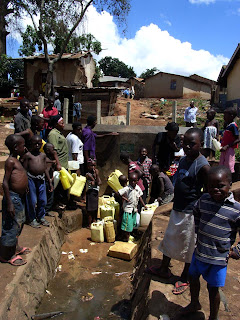Ziehier een stukje dat ik postte op de officiële VDOS-blog:
After half a year in Uganda, I am getting a better picture of the Kampala Integrated Environmental Planning and Management Project (or KIEMP as we call it - the project in which I am cooperating), bilateral cooperation, development work and Ugandan society. Kampala faces a lot of challenges, especially in the slum areas. KIEMP tries to tackle these issues, but it is only a pilot project and the needs are very high.
Rapid population growth of the city, estimated at 3.8 percent annually, is putting great pressure on the natural environment and its resources. Due to lack of space, people encroach on inappropriate areas such as wetlands which are prone to flooding. Stagnant water which remains after the floods is a breeding place for mosquitoes and favours the spread of mosquito transmitted diseases.

Houses being built in swamps sink slowly and are eventually abandoned

Stagnant water: breeding place for mosquitos
Apart from environmental damage – as the areas previously used to filter the water – the settlements arising are not planned for and thus lack basic infrastructure.
- Safe water supply is increasingly present in the areas, but has to be paid for. Therefore, many households, especially the poorest of the poor, use water from springs that originate in the area.

A protected well built by a previous project. The protected well is used by many people. Water quality is far from excellent, though, especially since unlined toilets have been constructed uphill
- Also for the use of toilets, one has to pay. Existing toilets in the areas are mostly unlined pit latrines, which, when filled up, will be emptied in the drains or moved to another place. They contaminate the ground water, and the structures have to be raised due to the high water table. This has consequences for safety.

A KIEMP toilet under construction in foreground. Construction has proven challenging due to the high water table in the parishes. In the background, an elevated toilet which is dangerous to access
- Drainages, if constructed, get blocked easily due to the practice of dumping waste into the drainages. This exacerbates the flooding, as the water cannot find an easy way out.

A drainage blocked by garbage
- Poor access roads and poor services complicate garbage management. Moreover, since these services also have to be paid for, a considerable amount of the waste ends up either in the drainages or on big piles on the side of the roads.

Waste dumped in the drainages

Waste being collected during a KIEMP cleanup campaign to raise awareness on the importance of a clean environment
- The majority of the residents are tenants who have no say over the improvement of the dwelling units yet landlords are reluctant to invest in these housing structures. Although landlords are legally obliged to provide a water borne toilet for every structure used for shelter, these regulations are not enforced.

Living conditions are far from ideal in the slums
Furthermore, because of the transient nature of the population, there is general apathy towards improving the environment. People will move on from one area to another in a relatively short period of time, so they do not 'own' the place they live, they do not have a sense of responsibility towards it, they do not care about its condition. Although it is important that infrastructure is present, it is how much the population is involved that will determine if the organized O&M (operation & maintenance) will work, which will determine the sustainability. Operation and maintenance has to be thought through before construction of the infrastructure starts. It is fairly easy to construct a water standpost, but if the taps are closed down only a few months later because of the arrears in payment of the water bill, the standpost will have been of very little use.
Kampala City Council (KCC) has not been able to enforce standards in the slum areas, many of which encroach on wetlands. Laws are obsolete, enforcement is politicized, corruption is everywhere and the approval of building plans is delayed so much that people attempt to 'short circuit' (=bribery). This has undermined environmental planning and management in the City. In the end, institutional capacity building is the ultimate goal of the project. When the city is well planned and managed and law enforcement is good, projects as KIEMP will be rendered redundant. The currently ongoing training needs assessment for staff of Kampala City Council and its Divisions is therefore of considerable importance.
No comments:
Post a Comment